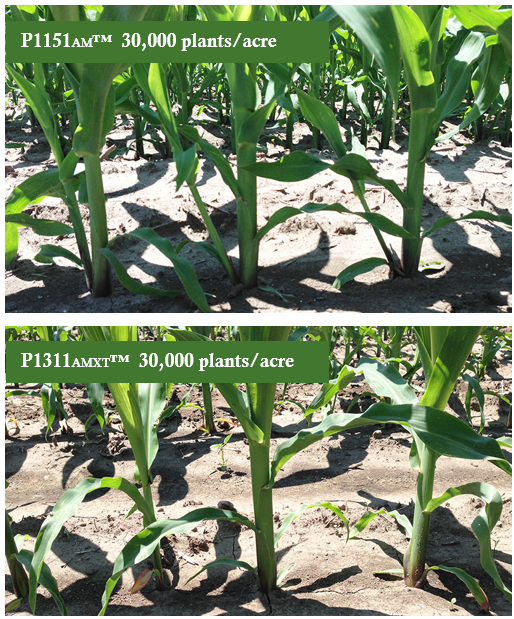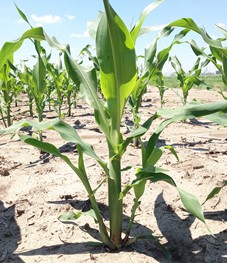In early research, tillers were removed from the main plant early in the season and yields were compared to similar plants that had their tillers left on all season. In these early studies, tiller removal never increased yields and usually reduced yields.
Tillers were known to have roots, but it was unclear whether the greater yields sometimes documented with tillers were due to the tillers feeding the main plant or because additional grain was produced in tiller ears. Another theory suggested it was neither, but rather that a yield decrease resulted from the slight injury incurred when removing tillers in these studies.

Figure 2. Two Pioneer® brand corn products* planted at 30,000 plants/acre in a Pioneer plant population study showing genetic differences in tillering. Top: Pioneer brand P1151AM™ (AM,LL,RR2) corn; Above: Pioneer brand P1131AMXT™ (AMXT,LL,RR2) corn (Johnston, IA; June 19, 2015)
Later, leaf removal studies were conducted to provide a better understanding of the relationships and potential nutrient exchanges between tillers and the main plant. Corn was grown at low plant populations so that large tillers would develop on many plants. Then all the leaves were removed from the main plant during early grain fill. Half of the defoliated main plants had tillers; the rest did not. The tiller leaves were left intact. Plants with tillers yielded nearly twice as much grain as did plants that had no tillers. It appeared that a connection existed between the tiller and the main plant that allowed food produced in tiller leaves to get to ears on the main plant.
More recent techniques allow for direct measurement of nutrient movement. Carbon is an important component of both sugars and proteins needed for ear fill. The carbon in carbon dioxide can be labeled with radioactivity. When this labeled carbon dioxide is taken up by a leaf, it can be followed throughout the plant. Detection of this labeled carbon in other plant parts (such as an ear) later in the season indicates movement of the original labeled carbon from the leaf to its final destination.
Plant physiologists at the University of Wisconsin using such labeling techniques found that little movement of food takes place between the main plant and tillers before tasseling. In contrast, immediately after silking and during grain fill, substantial amounts of food moved from leaves of large, earless tillers to the ear on the main plant.
However, there was little food movement when ears were on both the tiller and the main plant. In other words, main plant ears received their food from main plant leaves, while tiller ears received their food from tiller leaves. The only time food moved from main plant to tiller was when there was an ear on the tiller, but none on the main plant. This, of course, is not a likely situation under most field conditions.
These studies were conducted at a low plant population to stimulate the formation of large, healthy tillers. The small, shaded tillers without ears that normally develop under a full stand in normal field conditions will probably have little influence on the main plant. If there is a slight influence on grain yield it would most likely be to increase yields.
Under low plant populations, tillers may be large and numerous, but they will not deplete the main stalk of nutrients needed to fill the grain. In fact, in very low plant stand situations, tillers may actually contribute to increased grain yields by either feeding the main plant or by producing grain on their own ears.







